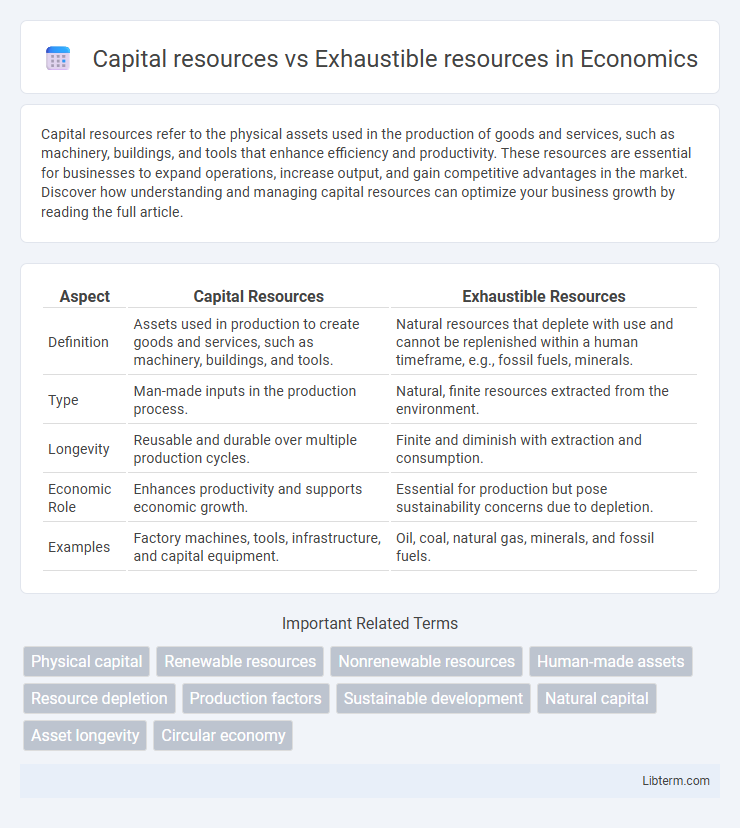Capital resources refer to the physical assets used in the production of goods and services, such as machinery, buildings, and tools that enhance efficiency and productivity. These resources are essential for businesses to expand operations, increase output, and gain competitive advantages in the market. Discover how understanding and managing capital resources can optimize your business growth by reading the full article.
Table of Comparison
| Aspect | Capital Resources | Exhaustible Resources |
|---|---|---|
| Definition | Assets used in production to create goods and services, such as machinery, buildings, and tools. | Natural resources that deplete with use and cannot be replenished within a human timeframe, e.g., fossil fuels, minerals. |
| Type | Man-made inputs in the production process. | Natural, finite resources extracted from the environment. |
| Longevity | Reusable and durable over multiple production cycles. | Finite and diminish with extraction and consumption. |
| Economic Role | Enhances productivity and supports economic growth. | Essential for production but pose sustainability concerns due to depletion. |
| Examples | Factory machines, tools, infrastructure, and capital equipment. | Oil, coal, natural gas, minerals, and fossil fuels. |
Understanding Capital Resources: Definition and Examples
Capital resources refer to man-made goods used in the production of other goods and services, including machinery, buildings, tools, and equipment essential for economic activities. These resources differ from exhaustible resources, which are naturally occurring and deplete over time, such as fossil fuels and minerals. Understanding capital resources highlights their role as durable assets that enhance productivity without being consumed in a single production cycle.
Exhaustible Resources: Meaning and Key Characteristics
Exhaustible resources are natural assets that cannot be replenished within a human timeframe, such as fossil fuels, minerals, and certain groundwater reserves. These resources are finite and diminish as they are extracted and consumed, leading to concerns about long-term availability and sustainability. Key characteristics of exhaustible resources include their non-renewable nature, economic value driven by scarcity, and the environmental impact associated with their extraction and utilization.
Economic Importance of Capital Resources
Capital resources, including machinery, tools, and infrastructure, are crucial for driving economic growth as they enhance productivity and enable the efficient production of goods and services. Unlike exhaustible resources, which are finite and deplete over time, capital resources can be replenished and improved through investment and innovation, supporting sustained economic development. The accumulation and effective utilization of capital resources lead to increased employment opportunities, higher income levels, and overall improvements in living standards.
Limitations of Exhaustible Resources in Modern Economies
Exhaustible resources, such as fossil fuels and rare minerals, face significant limitations in modern economies due to their finite availability and irreversible depletion, leading to sustainability challenges. Their scarcity often causes volatile market prices, supply disruptions, and increased extraction costs, which can hinder long-term economic growth. In contrast, capital resources like machinery and infrastructure can be replenished and upgraded, making them more reliable for sustained economic development.
Differences Between Capital and Exhaustible Resources
Capital resources refer to man-made assets like machinery, buildings, and tools used in production, while exhaustible resources are natural assets such as minerals, fossil fuels, and metals that are finite and depletable. Capital resources can be increased and maintained through investment and innovation, whereas exhaustible resources diminish with extraction and cannot be replenished on a human timescale. The key difference lies in sustainability: capital resources support ongoing production without depletion, but exhaustible resources face eventual exhaustion and require careful management to balance current use with future availability.
Renewable Versus Nonrenewable Assets Explained
Capital resources consist of man-made assets like machinery and buildings that aid production, classified as renewable because they can be maintained and improved over time. Exhaustible resources, or nonrenewable assets such as fossil fuels and minerals, deplete with use and cannot be replenished within a human timeframe. Understanding the distinction between renewable capital resources and nonrenewable exhaustible resources is crucial for sustainable economic planning and resource management.
Impact of Resource Depletion on Economic Growth
Capital resources, such as machinery and infrastructure, contribute to sustained economic growth by enabling continuous production and innovation, while exhaustible resources like fossil fuels and minerals face inevitable depletion that can constrain long-term economic expansion. The depletion of exhaustible resources leads to increased extraction costs, reduced availability of critical inputs, and heightened volatility in resource-dependent industries, which collectively hinder productivity and investment. Sustainable economic growth requires balancing capital accumulation with efficient resource management and investment in renewable alternatives to mitigate the adverse effects of finite resource exhaustion.
Sustainable Management of Capital and Exhaustible Resources
Capital resources such as machinery and infrastructure enable sustained production without depletion, while exhaustible resources like fossil fuels and minerals face irreversible depletion risks. Sustainable management of these resources requires optimizing capital investments to enhance efficiency and adopting conservation practices to extend the lifespan of exhaustible resources. Integrating renewable alternatives and recycling technologies supports long-term economic growth while minimizing environmental impact.
Innovations in Conserving Exhaustible Resources
Innovations in conserving exhaustible resources, such as fossil fuels and minerals, focus on enhancing efficiency and developing sustainable alternatives to reduce depletion rates. Advances in technology include improved recycling methods, carbon capture and storage, and the development of renewable energy sources like solar and wind power, which reduce dependence on non-renewable capital resources. These innovations not only extend the lifespan of exhaustible resources but also contribute to environmental protection and economic sustainability.
Capital Resources and the Shift Toward Sustainability
Capital resources refer to man-made assets like machinery, buildings, and tools used in production, playing a crucial role in economic growth and innovation. The shift toward sustainability emphasizes investing in capital resources that minimize environmental impact, such as renewable energy infrastructure and eco-friendly technologies. Sustainable capital resources promote long-term economic stability by reducing dependence on exhaustible resources, which are finite and degrade the environment when overused.
Capital resources Infographic

 libterm.com
libterm.com